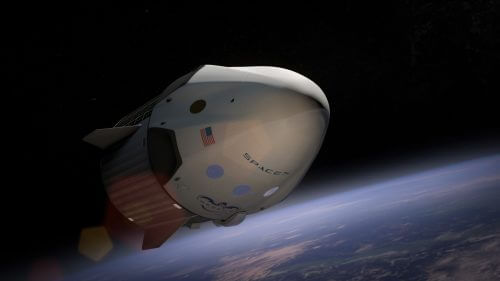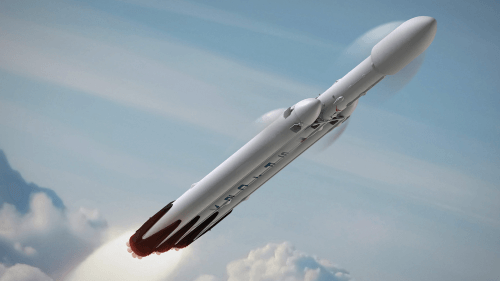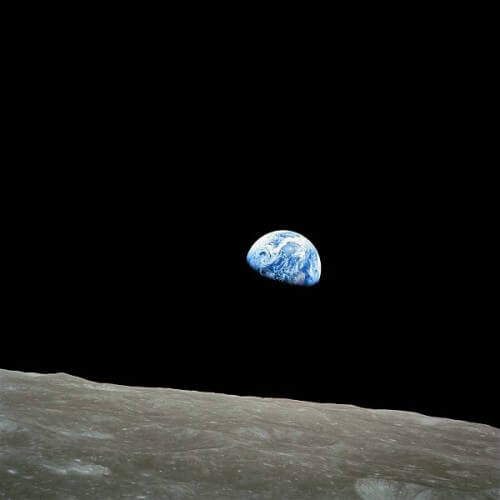Will you overtake NASA? SpaceX announced yesterday that two private individuals paid a "significant amount" for a manned mission around the moon, aboard the Dragon 2 spacecraft that the company is developing. If the plan goes ahead as planned, the spacecraft will be launched at the end of 2018, aboard the company's future launcher known as "Falcon Heavy".

In another grandiose announcement by the private company, which has so far managed to create a real revolution in the field of space, it announced that it will carry out a manned mission around the moon at the end of next year, which will be funded by two private individuals.
According to SpaceX, the mission was initiated by the two space tourists, whose names have not been published, and that they "already deposited a significant amount for the mission to the moon", according to Company announcement. The announcement also added that "like the Apollo pilots before them, these two men will fly into space carrying the hopes and dreams of humanity, and driven by the human and universal spirit of research." According to the company, there are other people interested in a similar "private trip" to the moon, and other such missions will be carried out in the future.
The two space tourists will be launched aboard the Dragon 2 spacecraft, a manned spacecraft that SpaceX is currently developing with the help and funding of NASA, to launch American astronauts to the International Space Station. The spacecraft is expected to perform its first unmanned test mission within the next year, and the first manned mission to the space station in the second quarter of 2018.
To allow the Dragon 2 spacecraft to reach orbit around the moon, it will not be launched on the company's famous Falcon 9 launcher, but on the more powerful "Falcon Heavy" launcher. Similar to the Dragon 2, the heavy Falcon is also planned for the first launch during this year, most likely this summer. The heavy launcher will consist of a combined assembly of three Falcon 9 first stages - which we have come to love From the videos of the landings their spectacular. On the middle first stage will be mounted the upper rocket stage and on it the launched cargo - two space tourists in the current case.

The mission is planned to last a whole week, during which the space tourists will fly around the moon and return to Earth. The message did not indicate entering orbit around the moon, so apparently it is only a single flight after which the spacecraft will immediately return to Earth.
According to SpaceX, the two anonymous space tourists will soon undergo a number of health and fitness tests, and later this year they will begin a training program for the flight to the moon.
If the company succeeds in realizing its ambitious plan on time, it will overtake NASA, which officially plans to send astronauts around the moon in 2021. Recently, under the influence of the new Trump administration, the American agency announced that it would examine the possibility of advancing the manned launch, and send a team of astronauts around the moon already on the first test flight of the heavy launch vehicle developed by NASA, SLS. But even if NASA's new proposal is approved, the manned launch will probably not happen before 2019.
The new announcement by SpaceX should be taken with caution. Like many other companies and space agencies, it has quite a bit of experience announcing bombastic plans and later quietly rejecting them. For example, last year is She announced that an unmanned Dragon spacecraft will be launched in 2018 to land on Mars, but recently it Has announced that you postpone the launch to 2020, to focus on the many other plans the company has.
In addition to the tight schedule, the company's announcement was rather terse and lacking in many details. For example, it is not clear whether the space tourists will be launched alone or with an experienced space pilot, or perhaps one of them already has some experience in the field, or such experience is not necessary at all.

Launching into orbit around the moon, into "deep space", also poses many challenges that do not exist in near-Earth orbit, where the International Space Station is located. For example, a week-long journey requires more supplies and equipment than a short mission to the space station, and to get to the moon you have to go through The Van Allen radiation belts which may be dangerous to humans.
We should also not forget the most important issue - the safety of the astronauts' lives, an issue that will also affect SpaceX's more central plan to send astronauts for NASA to the space station. Recently a report by the Government Accountability Office warned From cracks in the turbo pumps of the Falcon 9 engines, the same engines that will also be in the heavy Falcon launcher. The company responded to the report by saying that although the cracks do not pose a risk, it will soon unveil a new, and final, model of the Falcon 9, in which the problem will be solved. And of course, you can't forget Explosion Last year's Falcon 9 launcher, which resulted in the destruction of the Israeli Amos 6 satellite.
But even if the schedule is delayed, SpaceX proves once again its innovation and revolution in a field that was, until a few years ago, the exclusive domain of governments and a number of huge companies, such as Boeing for example. Additionally, if this new space tourism program bears fruit, it could help raise the capital needed to realize the long-term vision of SpaceX founder Elon Musk. colonize mars.

4 תגובות
Dima I didn't understand what's wrong with this translation? How would you translate "Falcon Heavy" into Hebrew?
Although it sounds a bit pretentious, and conservatives will say suicide, where do you register?
A few comments on this eye-opening announcement….
The people who will fly will be meaningless at all for the flight. The entire flight will be automatic and remotely controlled and for the purpose of the scientific matter, the meaning of their being there is zero...
SpaceX today has the ability to fly people to the moon, but it does not have the ability to bring them back alive and well.
When returning from the moon, the return speed to Earth is 40000 km/h and not 27000 km/h, which is a completely different story.
Who finances such an operation for them? Flying to a low orbit around the earth is also a very expensive project. NASA funds it for them. Who is financing this project, a lie and infinitely complicated?
Building a rocket and spaceship for this operation takes quite a long time, especially if it's the first time. I really don't see how they do this project in such a short time schedule.
What, they're going to do it without an unmanned test spaceship for the first time?
A heavy falcon?! Did you translate it with google translate?